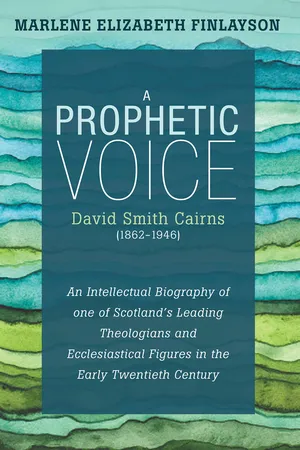![]()
Chapter 1
Religious Inheritance and Spiritual Crisis, 1862–1880
The Early Years at Home
It was into this ecclesiastical family, that David Smith Cairns was born in the United Presbyterian manse in Stitchel, near Kelso, in the Scottish Borders, on 8 November 1862. The manse was large enough to accommodate a family of six and a maid (the defining characteristic of the middle class in the mid-Victorian period). Cairns had three siblings: John (1857–1922), Jessie Brown Cairns (1859–1938), and William Thomas (1868–1944). The house stood on an elevated site, and from its secluded garden could be glimpsed not only green meadows, forests, and cornfields, and low wooded ridges with the Cheviot Hills in the distance, but the sites of historic battles between the English and the Scots. Hume Castle, to the north of Stitchel, was just one of the many grim reminders of four centuries of border warfare that had brought so much tragedy and suffering to the area. The traditional songs and ballads ensured that historical events remained in the consciousness of the Borders people. It is unsurprising that this region, steeped in history, should produce in Cairns a thinker for whom the historical perspective in theology was of the utmost importance.
The village, situated on the crest of a hill, six hundred feet above the banks of the River Tweed, consisted of one street with two rows of red-roofed laborers’ cottages, a joiner’s shop, a smithy, a school, and a police station. At the top of the street were the parish church and glebe, while the United Presbyterian Church was in the middle, with its manse at the bottom. Farmhouses nestled in the low hills round about, and near the parish church was the imposing gateway of the mansion house of the laird, George Alexander Baird, whose family had made its fortune by investing in the mining industry and the railways. While the young laird squandered his inheritance in a dissolute life, the agricultural community around him worked hard and thrived. Farming was mostly arable, although cattle and sheep were kept for the southern markets, and the Eden Water (a tributary of the Tweed) with its pools and waterfalls provided a plentiful supply of trout.
Cairns’s formal education began only two miles from home, in the village school in Ednam, where his father was a member of the school board. Even in old age, D. S. Cairns was able to recall both the layout of the interior of the building and the character of the dominie, David Pringle, who was much respected by children and parents, and had received some of his education at the university in Edinburgh. Pringle’s reputation as being outstanding among the region’s schoolmasters drew pupils from as far away as Kelso, and included a contingent from Stitchel. With two pupil teachers to assist him, Pringle might have between 120 and 150 pupils. In the year after the 1872 Education Act made education compulsory for children between five and thirteen, Pringle records Cairns’s first day at school as 2 October 1873, when he was eleven years old, and that he had not attended any other school before Ednam. It may be that he had been tutored at home until this point. There was a school in Stitchel, but its reputation fluctuated over the years, and in May 1875 a school inspector criticized it, recording, “Discipline bad. No geography, no history and no arithmetic books.” Less than a year after entry at Ednam, Cairns passed the new Standard V examinations (equivalent to the old Qualifying examination), and was ready to leave the school in September 1876, when he was fourteen years old. As was the custom of the day, Pringle trained his students to memorize the Shorter Catechism. The authors had designed it for those who found the Longer Catechism too difficult: “for those of weaker capacity”; although as Cairns pointed out, it was still quite beyond young children. He admitted,
On a more humorous note, Cairns described Pringle’s method of getting the children to learn the 107 questions, by dividing them into teams who vied for a money prize that would later allow the victorious squad to buy peppermints. “So the great system of Geneva, or at least the words of it, passed into our memories without stripes or tears.”
Following Ednam, Cairns attended Kelso High School, a fee-paying establishment for boys. Here the pupils’ fees depended on the subjects they took, the most expensive being Latin, math, and Greek, which Cairns took along with science, French, and German. There was obviously some parental aspiration for him, although his ambition at this time was to be an architect or to go into business, as he “hoped to be the money-maker of the family.” He did fairly well at the high school, winning some prizes including a medal for arithmetic; however, when he looked back on his time there he did not think very highly of the standard of education that it offered. He enjoyed cricket, football, and rugby although he did not excel at any of these, and throughout his school years there was no indication of the ill-health that was to plague his university years.
Ecclesiastical Roots
An appreciation of the ecclesiastical tradition to which the family belonged, and of the issues that preoccupied its ministers and theologians in the second half of the nineteenth century, may shed some light on the religious atmosphere of the home. This was a family that was proud of its membership of the United Presbyterian Church, which Aileen Black describes as having a “vigorous religious culture” that originated in the industrialized villages and small towns of the Scottish lowlands.
In 1861, the year before Cairns’s birth, the population of Stitchel village was 425. Despite its small size, there were two churches: the established parish church and a Secession church. C...
